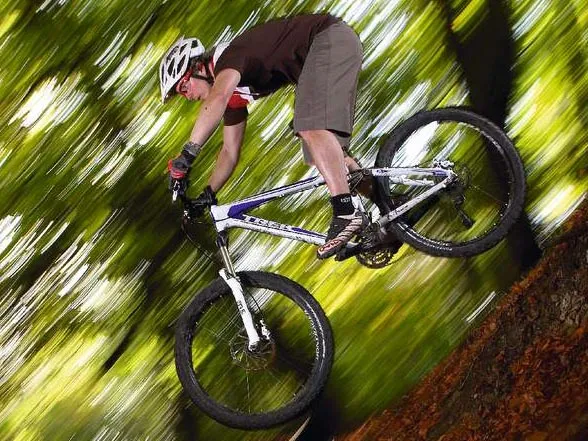Fatter rims and an extra large can on the shock mean there’s more air everywhere on the 2009 Trek Fuel Ex 7 – and it’s more confident getting lift on the trail or delivering grins on the descents as a result. But the extra weight means you’ll need more muscle to launch it.
The latest incarnation of the Trek Fuel Ex 7 boasts bottomless-feeling, big hit suspension smoothness on a tough chassis. Its longer travel fork, fatter tyres and broad rims boost confidence. However, it's heavy for its cost and category and its slippery tyres and steady stem need upgrading ASAP.
Ride: communicative and confident
A few millimetres of rim width and fork travel and a few millilitres of shock capacity might not sound much difference, but as you sit behind the broad bars, the 2009 Trek gives a different vibe straight away.
It feels more connected, which translates directly into confidence in rougher sections of the trail. The bigger can and floating shock create a bottomless feel that many long travel bikes would envy.
There’s never any need to flick levers on the shock to get it going either. As long as you keep the pedals turning the back wheel keeps tracking the trail despite any step-ups or stutter bumps.
There’s no lack of fine feedback for getting the best from the tyres and the Ex certainly flatters them with what it gets down, up and through. It lifts and launches well too – once you learn to use your bodyweight as extra leverage.
But there’s no escaping the fact it’s harder to pick up speed and hold it than it should be for this price and class of bike. We also can’t avoid feeling that a shorter stem than the 105mm one fitted would inject some welcome reaction speed into the Ex’s naturally playful but slightly placid handling.
Frame: minor tweaks to a platform ahead of the curve last year
The Fuel Ex chassis doesn’t change for 2009, but the massive reworking it got last year – big hydroformed frame tubes, hourglass head tube and a 3D forged EVO rocker link – is still state-of-the-art in trail bike terms. The main difference here is that the already good ABP/Full Floater suspension system is boosted in overall smoothness and big hit capability with an XV (eXtra Volume) air can upgrade for the capable Fox RP2 shock.
We hammered an Ex all the way through last year, so we know the new frame and the bearings hold up well regardless of the weather and workload. The triple keyhole seat clamp slots don’t have an undue thirst for rear wheel spray either and although you can’t drop the saddle right down, it does go far enough for steep descending.
With a frame as butch and stiff as this, we feel Trek may have missed a trick by not using Maxle or a similar oversized screw-through axle at the back. It wouldn’t make a difference to operational speed, but it would boost rear stiffness for just a few grams.
One thing we like about the Ex is the greater range of sizes covering the mid-range, with the 18.5in (large-medium) we tested closing the previous gap between the small 17.5in and gate-like 19.5in versions.
Equipment: powerful but weighty
Trek hasn’t skimped when it comes to components either, which has a direct effect on control levels. The Motion Control damping of the RockShox Recon 351 fork is great, so while the 130mm (5.1in) front fork might seem mismatched to the 120mm (4.7in) out back, it adds confidence when you’re charging headlong into rough terrain. The same goes for the broad 28mm Bontrager rims and the fat carcass 2.2/2.25in tyres. The wide bar (26in) helps you hold sketchy lines and hit turns tight and late too.
However, the Recon’s weight is a drawback, and the big rims and rubber add more heft where it matters most for acceleration. And even though they’re plump and protective, you’ll soon find the traction limits of the XR tyres when it starts getting slippery.
In terms of getting power down, the Shimano to go and Avid to stop mix of kit is nothing more than fine, but the rest of the Bontrager finishing kit is spot on.





